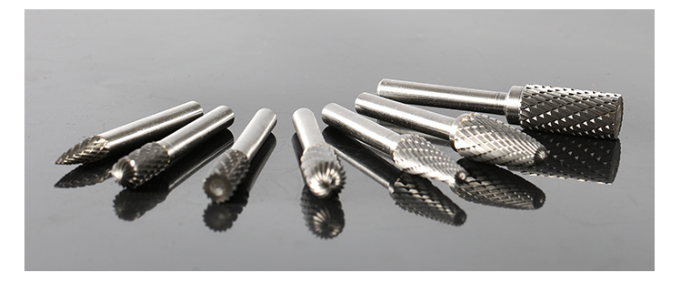
Carbide Rotary Burrs are used for cutting, shaping, grinding and for the removal of sharp edges, burrs and excess material (deburring) and this is what we talk about in the following article.
For drilling holes or cutting a hole in metal then a carbide drill or a carbide end mill, carbide slot drill or a carbide router is required rather than a carbide burr. For carving into stone you would ideally use a Diamond Burr.
1. Carbide Burrs Can be Used on Many Materials
Tungsten Carbide burrs can be used on many materials: metals including steel, aluminum and cast iron, all types of wood, acrylics, fibreglass and plastics. When used on soft metals such as gold, platinum and silver, carbide burrs are ideal as they will last a long time with no chipping or breaking.
Steel, Carbon Steel & Stainless Steel
Cast Iron
Aluminium
Titanium
Cobalt
Nickel
Gold, Platinum & Silver
Ceramics
Fibreglass
Plastic, Carbon Fiber Reinforced Plastic (CRP), Glass Fibre Reinforced Plastic (GRP)
Brass, Copper & Bronze
Zinc
Wood
Different cuts of carbide burrs will be best suited to certain materials, see the next point below to find out about the different cuts.
2. Carbide Burrs Commonly Come in Two Cuts; Single Cut and Double Cut
Single cut (one flute) carbide burrs have a right handed (Up cut) spiral flute. These tend to be used with stainless steel, hardened steel, copper, cast iron, and ferrous metals and will remove material quickly with a smooth finish. Use for heavy stock removal, milling, deburring and cleaning.
Heavy removal of material
Milling
Deburring
Cleaning
Creates long chips
Double cut carbide burrs tend to be used on ferrous and non ferrous metals, aluminium, soft steel and also for all non-metal materials such as plastics and wood. They have more cutting edges and will remove material faster. Double cut are sometimes referrred to as Diamond Cut or Cross Cut (2 flutes cut across each other) will leave a smoother finish than single cut due to producing smaller chips as they cut away the material. Use for medium-light stock removal, deburring, finishing and cleaning. A double cut carbide burr is the most popular cut and will see you through most applications.
Medium- light removal of material
Deburring
Fine finishing
Cleaning
Smooth finish
Creates small chips
3. The Various Shapes of Carbide Burrs and How To Use Them
Making a decision on what shape to use will depend on the profile or cut you are looking to achieve.
These different shaped burs will get into many a nook and cranny and produce some interesting profiles.
carbide ball Burrs
Carbide Tree Burrs
Carbide Inverted Cone Burrs
Carbide Pointed Cone & Carbide Round Nose or Ball Nose Burrs
Cylinder Burrs. Round Nose/Ball nose/End Cut
Oval Burrs
Flame Burrs
Countersink Burrs
4. What Speed or RPM should you use your Carbide Burrs?
The speed at which you use your carbide bur in your rotary tool will depend on the material you're using it on and the contour being produced but it's safe to say you do not need to exceed speeds of 35,000 RPM.
If the burs are chipping easily this could be due to the speed being too slow. However, it's ideal to start the bur off slow, increasing the speed as you go along. High speeds will prevent clogging in the flutes of your burs.
5. Do Not Apply Too Much Pressure
As with all drill bits and burrs, let the burr do the work and apply only a little pressure otherwise the cutting edges of the flutes will chip away or become smooth too quickly, reducing the life of your burr.
6. Carbide Burrs are Harder Than HSS Burrs
Our Carbide Burrs are machine ground from a specially chosen grade of carbide. Due to the extreme hardness of the Tungsten Carbide they can be used on much more demanding jobs than HSS (High Speed Steel).
Carbide Burrs also perform better at higher temperatures than HSS so you can run them hotter, and for longer.
HSS burrs will start to soften at higher temperatures so carbide is always a better choice for long term performance.
7. Keep The Carbide Burr On The Move
When using your carbide burr try not to keep it still for too long as this will prevent the burr from digging and jabbing into your material causing unsightly marks and roughness.
Contact: Julia Long
Phone: 86-15197383063
Tel: 86-731-22283096
Email: info@zyjcarbide.com
Add: No.52 Hongqi North Road,Shifeng District,Zhuzhou,Hunan,China